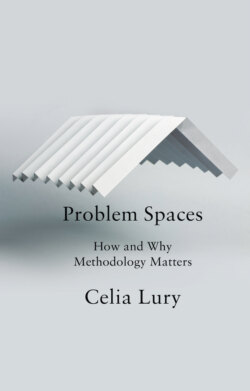Читать книгу Problem Spaces - Celia Lury - Страница 8
Compositional methodology
ОглавлениеThe activity of composing is not given in advance of a problem, but is rather ever forming and transforming across a problem space. It rarely involves just one action or operation – sensing, categorizing, conceptualizing, scaling, measuring, affecting, experiencing, varying, but involves the doing of many together. In other words, compositional methodology presumes and exploits the fact that a problem is not given but emerges with-in and out-with a myriad sequence of actions or methods that (trans)forms the problem space. Importantly, this sequencing is not the addition of one action or method after another, but a composition in the sense that the actions or methods are not discrete or independent of each other. As ‘it’ happens, a compositional methodology seeks to recognize and exploit the properties of the problem on an ongoing basis. It composes a problem by recognizing and making use of (rather than minimizing) the constantly changing limits that create a problem and a problem space together, identifying and operating the intensive or ‘live’ properties of the problem it investigates (Back and Puwar 2012).
Compositional methodology is, then, concerned with form in and as transformation, a process involving ‘the interweaving of data, form, transition, and issue’ (Whitehead 1968: 210) organized by the compulsion of composition:
It is not that which is discriminated that is most real, nor is it a completed, self-sustaining composition. But instead the compulsion of composition. (Whitehead 1968: 133)
To adapt Rockburne’s title, for compositional methodology a situation or phenomenon becomes a problem, acquires a form, trans-forms, as a ‘problem that problematizes itself’; that is, compulsive composition is the repeated folding or twisting of problems into forms of problematization. In this twisting, the problem is revealed never to be simply a problem, but also a composition of the methodological potential of a problem space to be expressed in transformation. This is to say problems and problem spaces are compulsively composed together.
Let me give another example, taken from a discussion of the development of staging models for the diagnosis of tuberculosis by Geoff Bowker and Susan Leigh Star (2000). In a first model – a body–biography chain, the biographical trajectory of an individual and the trajectory of their illness are placed alongside each other.
Figure 2 Model I: Body–biography trajectory
Source: Geoff Bowker and Susan Leigh Star (2000)
In a second model, multiple biography/identity trajectories are introduced, as a way of recognizing the multiple dimensions of an individual’s life, complicating the understanding of the course of illness in relation to the person who is ill.
Figure 3 Model II: Multiple identity trajectory
Source: Geoff Bowker and Susan Leigh Star (2000)
In both these models, the problem space is a container space. However, in a third model, the external linear time of the classification system is folded into the model: continuities, discontinuities and layers are introduced into the problem space. In the action of folding the epistemic limit of the classification system across the trajectories, the model becomes expressive; that is, the model acquires inventive methodological potential in the folding of ‘the outside’ of the problem into the ‘inside’. It is encapsulated. As Bowker and Star put it, there is a topology–typology twist: ‘The topology created by the body–biography trajectory is pulled against the idealized, standardized typology of the global classification of tuberculosis, itself a broken and moving target’ (2000: 190).
To return to the vocabulary introduced in the discussion of Rockburne, this model involves the action of folding the external limit of the classification system into the problem. That is, the method of folding changes the problem even as it persists, creating new methodological potential in the process of transformation. In other words, it is not just a problem that is defined in transformation, but the problem and the problem space, as they are compulsively composed together.
In what follows it will be suggested that compositional methodology is concerned with the way in which a problem emerges in the relation between two moments; that is, with the addressing of a method or methods to a specific problem, and the capacity of what emerges in their use to change or transform the problem (Rheinberger 1997). As Nina Wakeford and I (2012) argue, it is the relation between these two moments that makes methods answerable to a problem, and provides the basis of the self-displacing movement or auto-spatialization of a problem. We further argue that the inventiveness of methods is a consequence of the articulation of their double force: their constitutive effects and their capacity to contribute to the generative circulation of the problem. Here I suggest that a compositional methodology acknowledges and exploits the fact that the double force of auto-spatialization does not operate to create a space that contains the problem, but, rather, has as its aim the composition of a problem across a problem space that is itself changing.4 Indeed it is proposed that it is the accomplishment of some kind of continuity and connection in the transformation of a problem that secures epistemological value.
Figure 4 Model III: Classification trajectory
Source: Geoff Bowker and Susan Leigh Star (2000)
